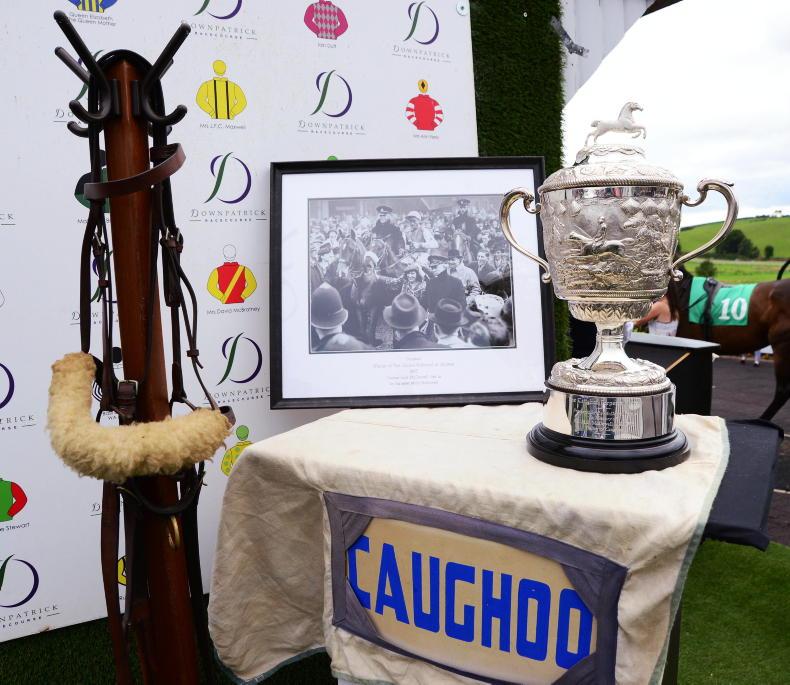AS a two-year-old colt, Caughoo was sent to the Ballsbridge Sales in Dublin where he was bought by Herbert McDonnell from Malahide for only 50 guineas in 1941.
He was later sold to Herbert’s brother, Dublin jeweller Jack McDowell. They named him Caughoo after their father’s estate in Co Cavan.
The Bloodstock Breeders Review in 1947 had this to say of the horse: “Caughoo is a dark brown horse with no distinctive marks other than a prominent star. Measuring 15 hands 3 inches, he is well proportioned, with plenty of power behind the saddle, good length from hip to hock, the hocks low set.
“He has a fine little bloodlike head, a very bold eye and an engaging way of showing his teeth, rather like a dog when it smiles.”
Jack McDowell played rugby at nearby Suttonians and adopted their club colours for his racing silks, royal blue, green and white. Caughoo’s early career was poor in terms of success when racing on the flat, and he was never placed. However he was then schooled over fences and his luck began to change.
Caughoo’s association with Downpatrick Racecourse began in 1945 when he won the Ulster Grand National under Brendan O’Neill. Not satisfied with having one Ulster Grand National win under his belt, Caughoo continued his winning streak at Downpatrick by winning the race again in 1946, ridden by Aubrey Brabazon
In 1947, the snow lay on the ground for months and many a race meeting was cancelled. Caughoo had been lucky as he had the opportunity to work on the beach between Portmarnock and Malahide in Co Dublin, which some English trainers complained had given him an edge throughout the tough weather.
The beaches became a second home to Caughoo as he rolled about and raced through the water, watched by his ‘lad’ Ted Wright.
Outsider
At Aintree he wasn’t well backed, going to post as a 100/1 outsider, and 250/1 on the Tote. However, thanks to a dream the night before, one lucky Co Clare farmer backed him, and as a result collected the princely sum of £3,000 afterwards. He then sent one third of those winnings to the Pope to aid starving children, as he had a guilty conscience because he ‘knew’ from his dream that Caughoo would win.
The trip around Aintree was also a new experience for Caughoo’s jockey Eddie Dempsey, as he had never been in England before. The Grand National was his first win in three years and he had previously been headman to Tom Dreaper for three years in the early 1940s.
An excerpt from The Irish Field on the 5th of April 1947 said of Dempsey’s success: “Caughoo’s jockey, E. Dempsey, deserves full credit. Dempsey who had several winners in point-to-point races before taking out a professional rider’s licence, had not ridden a winner for three years prior to Saturday’s triumph.”
On the day of the Grand National, after setting off around the track enveloped by the poor weather, the field of runners returned out of the mist at the end of the first circuit, with Caughoo nicely placed in the second group. Once more they disappeared and, on their return and with two fences to jump, it was Caughoo who was in the lead, striding on to victory.
Great debate
There was great debate afterwards, with Lough Conn’s jockey Dan McCann allegedly stating that Eddie Dempsey had waited for the second circuit in the mist and therefore didn’t complete the full course. Photographic evidence showed, quite clearly, that this did not happen.
Downpatrick Racecourse is fortunate to have first-hand accounts and memorabilia of Caughoo’s talent and his win in the Grand National. They have, on display, some of Caughoo’s belongings that helped put him and Downpatrick firmly on the map.
Back again to the Bloodstock Breeders’ Review in 1947. It said: “His place in the Hall of Fame is at any rate secure, and he may be remembered as an honest-to-goodness little horse, a great jumper and stayer, and as game as a pebble.”


 This is a subscriber-only article
This is a subscriber-only article
 It looks like you're browsing in private mode
It looks like you're browsing in private mode











SHARING OPTIONS: